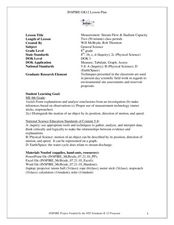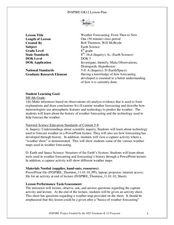Curated OER
Microscopes: Is what you see, what you got?
Eighth graders identify the parts and functions of the microscope. For this biology lesson, 8th graders observe different samples under different types of microscopes. They compare and contrast the details they see.
Curated OER
Measurement: Stream Flow & Stadium Capacity
Eighth graders study the scientific fields and how information can be monitored and recorded. For this scientific inquiry lesson students view a PowerPoint presentation and complete a hands on activity.
Curated OER
Electric Field Mapping in 3D
Students create a 3D vector field map of an electric field. In this physics lesson, students measure the voltage inside an aquarium with water. They present their findings and map to class..
Curated OER
Philadelphia Museum of Art
Students study paintings and use their knowledge of story elements to analyze the art. In this art analysis instructional activity, students review a novel for its elements. Students study the image At the Moulin Rouge: The Dance and...
Curated OER
Magic Eye
Students discuss the history of tobacco bag stringing. In this primary documents history lesson, students closely examine photographs of families who worked stringing tobacco bags. This lesson includes discussion questions and a...
Curated OER
Let's Roll Robots!
Students write a story about robots. In this creative writing lesson, students read a story about robots, make their own robot, and write a story about their robot. In addition, the lesson plan suggests taking photos of the robots to add...
Curated OER
Architecture of the Skeleton
Students experiment with skeletons. In this bone health instructional activity, students analyze, construct, and perform comparative investigations with bones. They make inferences about the structure and function of various bones. This...
Curated OER
African Americans Seen Through the Eyes of the Newsreel Cameraman
Fifth graders examine the portrayal of African Americans in the media. In this socio-political lesson, 5th graders view various news clips of African Americans and discuss the way they are presented. Students create narrations of the...
Curated OER
Arctic cleanup
Ninth graders examine pollution problems and how it affects the community. In this arctic cleanup lesson plan students study ocean currents and how they affect pollution.
Curated OER
Weather Olympics
Students consider the effects of topography on climate patterns. In this earth science instructional activity, students research weather patterns and make inferences of how the land forms may create different climates. Students compare...
Curated OER
Piecing Together the Story of Glenn Cunningham: A Kansas Champion
Students use primary and secondary sources to conduct research about Glenn Cunningham. In this Glenn Cunningham lesson plan, students tell why he was a hero, and tell facts from what they learned.
Curated OER
Weather Forecasting: From Then to Now
Eighth graders review the history of weather forecasting. In this earth science lesson, 8th graders identify the different tools used in forecasting weather. They explain why it's important to know the weather.
Curated OER
Fossils
Pupils act as paleontologists to discover who a mystery guest to the classroom was. They do not know the identity of the guest but infer the identity from items left behind in the classroom. They make inferences from dinosaur fossils.
Curated OER
Digging Deeper in Mission San Saba
Seventh graders explain Spanish motives for establishing Mission San Sab?? and the reasons for the mission's failure. This lesson should be used when students already have an understanding of the Spanish mission-presidio system in Texas.
Alabama Learning Exchange
As Large As Life. . . A Poster of a Human Body System
Learners explore the major systems and functions of the human body. In this anatomy lesson, students make life-size outlines of bodies, diagram body systems, and present their work to their classmates.
Curated OER
Those Cells Look Good Enough to Eat
Students explore the parts of the cell. In this cell lesson, students use foods to create cell models that represent the nucleus, cytoplasm, cell membrane, mitochondria, ribosomes, vacuoles, endoplasmic reticulum, and Golgi bodies...

















